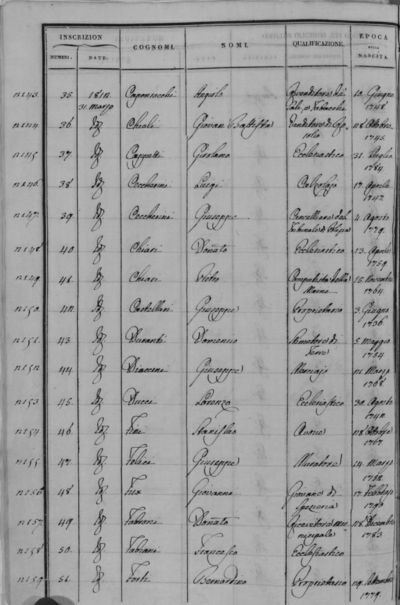In previous columns, we explored Italian civil, military and church records. This month, we are going to dig into Italian census records. An interesting aspect of Italian census records is their availability and contents vary based on the history of a region. The first true Italian census took place in 1871 after unification, but census-like records were compiled as far back as 1379 in Venice. Their original purpose was to facilitate the assessment of taxes. Due to their variety and uniqueness, we are going to focus on the major types of census-like records.
Catasto Onciario
Catasto Onciario is a record that was created between 1742-1753 for villages found in the Kingdom of Naples. It was ordered by the Bourbon King Charles III beginning in 1741, but not every community complied. If a record exists for your ancestral village it can be useful for filling in your family tree for those ancestors who lived before the start of the 1809 civil registration. In the catasti are annotations for each household: who lived in the house, their ages, relationships, and any ownership of valuable personal property such as land and livestock. Two copies were made, one was kept at the Provincial archive and the other sent to the Archivio di Stato in Naples. To find if a catasto exists for your ancestral village go to www.italyheritage.com/genealogy/catasti. You can purchase copies by sending an email to the Naples archives (This email address is being protected from spambots. You need JavaScript enabled to view it.). The records are handwritten and sometimes voluminous for an average-sized village. Generally, the archives will sell you a copy of the entire village’s catasto. A copy of one village’s records can cost several hundred euros. Fortunately, there are some villages for which the catasti have been digitized and are available online. In other cases, researchers have complied the records into books which can be purchased on Amazon or eBay. Before you contact the archives, do a google search using the name of your village and the terms catasto onciario to see what might be available.
Riveli di Beni e Anime
Riveli di Beni e Anime are records that were created for the villages on the island of Sicily for the period 1548-1831. The documents are kept in the Archivio di Stato in Palermo. They contain the names of the heads of families, including data on the composition of the family and lists of assets such as houses, land and animals as well as debts. Fortunately, you may be able to find your Sicilian village’s riveli online at www.familysearch.org. You will need to create a free account at familysearch to search records. This you can do from home but to view the actual records you will need to visit your local family history center. To find if your village’s riveli are available, search the online catalog by entering the name of the village in the “place” field. Once the list of records pops up, look on the list for census. If you are not sure how to navigate FamilySearch.org, there are volunteers at your local Family History Center who can help you.
Censimento
The first official Censimento (census) was completed in 1871 and was repeated every 10 years, except for 1941. Although Censimenti records are not available to the public, there were some villages and districts that conducted their own census for various reasons. These were done in random years and some of these records have been digitized and are available on the Portale Atenati (Ancestor’s Portale). Search the records on the portal at www.antenati.san.beniculturali.it, go to “browse registries” and look for your ancestral province. Because these censuses were taken at random intervals, you will need to search through both the Stato Civile Napoleonico and Stato Civile della Restaurazione record sets.
Status Animarium / Stato delle Anime (State of the Souls)
There is one additional census-like record that bears mentioning: the Status Animarium or Stato delle Anime. Beginning in the early 1600s, Catholic priests were instructed to create books to record family sacraments. These books will be found in the local parish and are extremely useful in building out your family tree when civil records are non-existent. How to find which parish to contact for copies was discussed in the April 2019 column and how to write for Italian records was the topic of the May 2019 column, refer to them for further guidance. Happy ancestor hunting!



